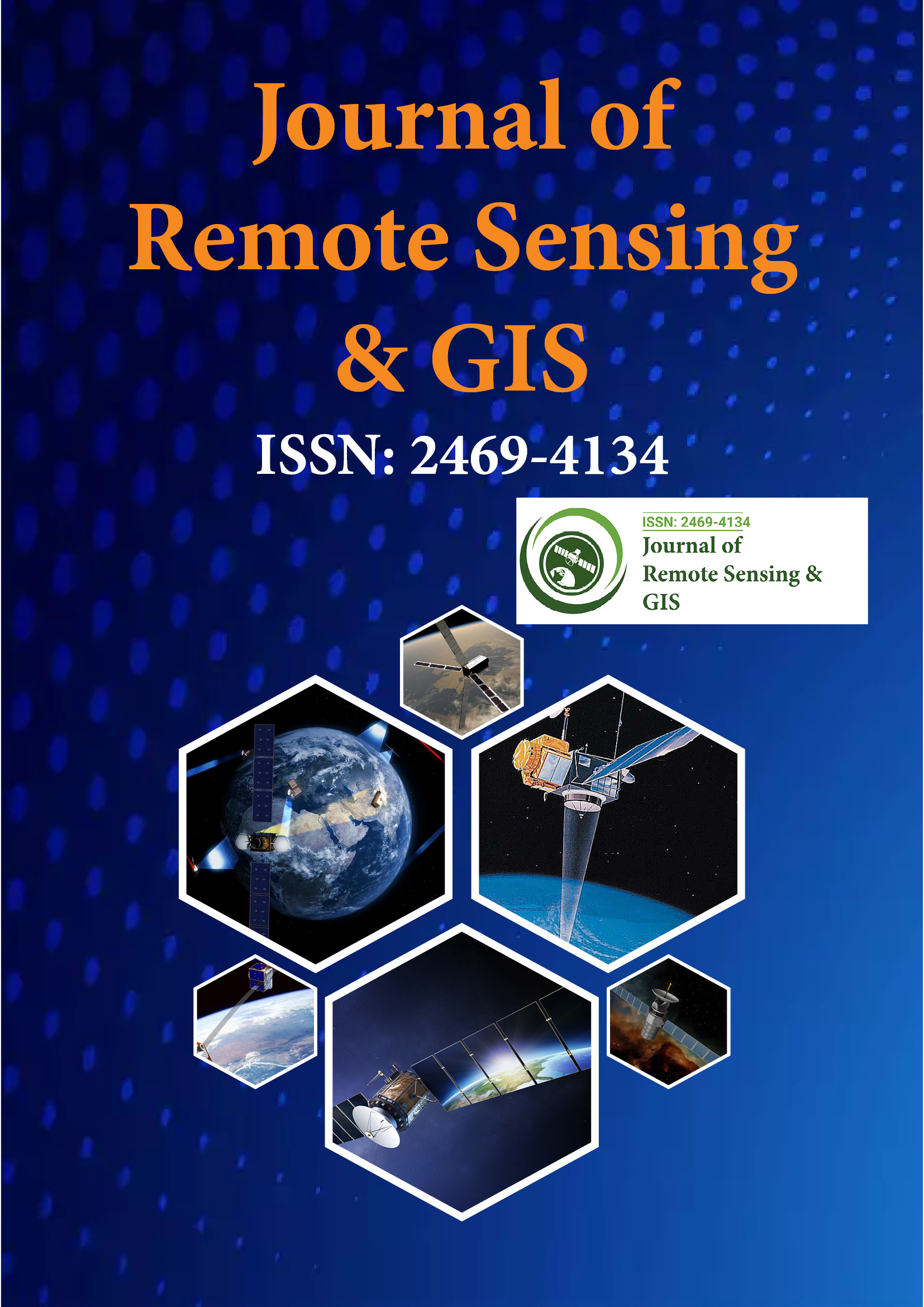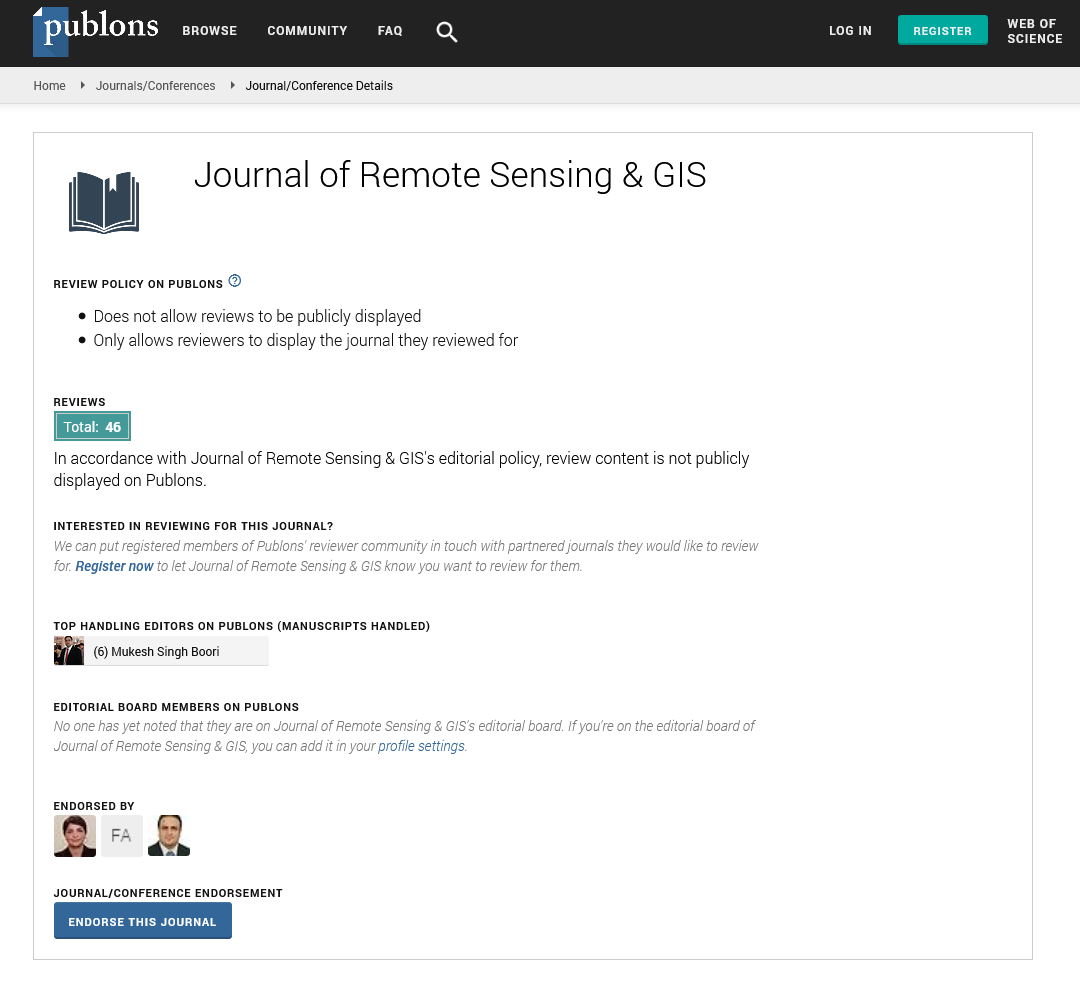Indexed In
- Open J Gate
- RefSeek
- Hamdard University
- EBSCO A-Z
- OCLC- WorldCat
- Publons
- International Scientific Indexing
- Euro Pub
- Google Scholar
Useful Links
Share This Page
Journal Flyer

Open Access Journals
- Agri and Aquaculture
- Biochemistry
- Bioinformatics & Systems Biology
- Business & Management
- Chemistry
- Clinical Sciences
- Engineering
- Food & Nutrition
- General Science
- Genetics & Molecular Biology
- Immunology & Microbiology
- Medical Sciences
- Neuroscience & Psychology
- Nursing & Health Care
- Pharmaceutical Sciences
Commentary - (2024) Volume 13, Issue 4
Advancing Urban Sustainability: Role of Remote Sensing in Planning and Development
Cheng Hue*Received: 25-Nov-2024, Manuscript No. JGRS-24-28059; Editor assigned: 27-Nov-2024, Pre QC No. JGRS-24-28059 (PQ); Reviewed: 12-Dec-2024, QC No. JGRS-24-28059; Revised: 20-Dec-2024, Manuscript No. JGRS-24-28059 (R); Published: 27-Dec-2024, DOI: 10.35248/2469-4134.24.13.360
Description
Urban planning and development are essential components of creating sustainable and efficient cities. As cities grow in size and complexity, innovative technologies have become indispensable for addressing urban challenges. Among these, remote sensing has emerged as a transformative tool, contributing unparalleled capabilities for collecting, analyzing and interpreting spatial data. By providing detailed awareness into urban environments, remote sensing supports informed decision-making across various dimensions of urban planning and development.
Monitoring urban growth and land use changes
Remote sensing technologies enable precise tracking of urban expansion and changes in land use over time. High-resolution satellite imagery and aerial photography are used to identify patterns of urban sprawl, monitor land conversion and evaluate the impacts of urbanization on natural resources. For example, multispectral and hyperspectral imaging can differentiate between urban structures, vegetation and water bodies, helping planners assess how land use evolves in response to population growth and economic activities.
Urban planners utilize this data to prepare growth models, allocate resources effectively and ensure that urban expansion aligns with sustainable practices. Time-series analysis of remote sensing data further aids in identifying trends and predicting future urban growth, enabling proactive planning measures.
Infrastructure planning and management
The planning and maintenance of urban infrastructure require accurate and up-to-date information about existing structures and facilities. Remote sensing offers comprehensive datasets for mapping roads, buildings, bridges and other infrastructure elements. LiDAR (Light Detection and Ranging) technology is particularly useful for creating detailed 3D models of urban areas, which assist in designing transportation networks, managing utility services and improving disaster resilience.
By integrating remote sensing with Geographic Information Systems (GIS), urban planners can develop interactive maps and models that visualize infrastructure distribution and identify areas requiring intervention. This approach streamlines infrastructure development processes, reduces costs and enhances operational efficiency.
Environmental monitoring and management
Environmental sustainability is a key consideration in urban planning. Remote sensing supports environmental monitoring by providing data on air quality, vegetation and water resources within urban areas. Techniques such as thermal imaging and radar sensing allow for the detection of urban heat islands, pollution hotspots and changes in green spaces.
This information enables planners to implement measures for mitigating environmental degradation, such as increasing urban greenery, improving waste management and optimizing energy use. Remote sensing also plays a significant role in assessing the risks posed by natural hazards, including floods, landslides and storms, helping cities prepare and adapt to such challenges.
Transportation and mobility analysis
Efficient transportation systems are important for urban functionality. Remote sensing contributes to the analysis and optimization of transportation networks by providing spatial data on traffic patterns, road conditions and accessibility. Highresolution imagery and radar systems are used to monitor congestion, identify bottlenecks and evaluate the performance of public transport systems.
By analyzing these datasets, urban planners can develop strategies to improve mobility, reduce travel times and minimize environmental impacts. Remote sensing also supports the design of smart transportation solutions, such as adaptive traffic management systems and infrastructure for electric vehicles, aligning urban mobility with contemporary technological advancements.
Urban health and quality of life
Urban planning aims to enhance the well-being of residents by addressing issues related to housing, public spaces and access to services. Remote sensing facilitates the identification of urban inequalities by mapping disparities in housing quality, proximity to amenities and exposure to environmental hazards. For example, thermal imaging can identify areas with inadequate insulation or ventilation, while multispectral data can assess access to green spaces. This information helps planners prioritize interventions and develop inclusive policies that improve living standards and promote social equity.
Integration with smart cities and emerging technologies
The integration of remote sensing with emerging technologies, such as the Internet of Things (IoT) and Artificial Intelligence (AI), enhances its applications in urban planning. IoT devices provide real-time data on various urban parameters, while AI algorithms analyse remote sensing data to generate essential data. These advancements support the development of smart city initiatives, enabling data-driven decision-making for energy management, waste reduction and public safety.
Furthermore, the use of drones equipped with sensors has expanded the scope of remote sensing in urban planning. Drones offer flexibility in capturing high-resolution images and real-time data, making them valuable for monitoring construction projects, assessing disaster impacts and conducting rapid surveys in inaccessible areas.
Conclusion
Remote sensing has revolutionized the way urban planners approach the complexities of city development. The role of remote sensing in urban planning is expanding, driven by technological advancements and growing urban challenges. Collaborative efforts among governments, academia and industry will be essential for addressing existing challenges and maximizing the potential of remote sensing in urban development. By integrating remote sensing with emerging technologies like IoT and AI, cities can achieve smarter, more sustainable growth in the future.
Citation: Hue C (2024). Advancing Urban Sustainability: Role of Remote Sensing in Planning and Development. J Remote Sens GIS. 13:360.
Copyright: © 2024 Hue C. This is an open-access article distributed under the terms of the Creative Commons Attribution License, which permits unrestricted use, distribution and reproduction in any medium, provided the original author and source are credited.

